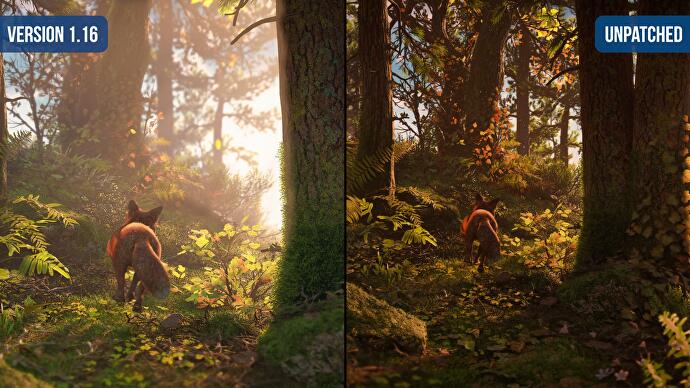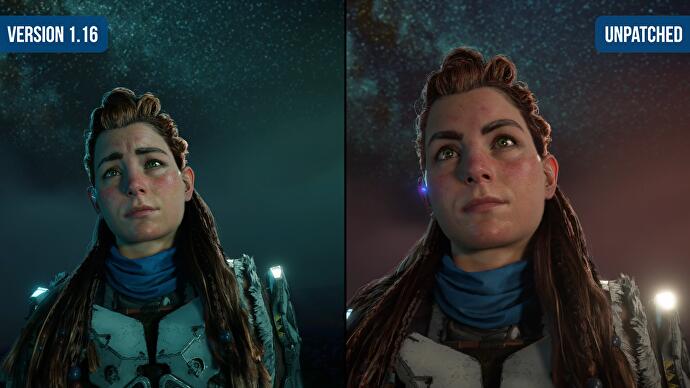Horizon Forbidden West: Improved Performance mode is now the best way to play

With the release of patch 1.16 for Horizon Forbidden West, the visual issues in the game’s 60fps performance mode have finally been fixed. This makes it our new recommended way to play on PS5, versus the 30fps mode we favored at launch. To find out exactly what changes have been made behind the scenes, we spoke to Guerrilla Games, who gave us some fascinating details about the game’s anti-aliasing solution and how it’s changed since launch.
So what were the original issues with the 60fps performance mode image quality? In short, this mode gave many objects a shimmering appearance, while even the higher fidelity 30fps mode showed a different kind of noticeable flickering in the foliage. Patch 1.07 included “tweaks to vegetation to improve performance mode image quality” but this had minimal impact on final image quality. Many were dissatisfied with the result.
Fortunately, Guerrilla has achieved significantly better results with patch 1.16. Looking at moss and vegetation, which showed annoying flickering in the launch version, the issue seems to be completely resolved. The image is stable and clean in motion, and flickering is virtually gone. Similarly, the problematic red fog, which had obvious visual divergences in the launch version, appears much more coherent in version 1.16. However, it seems that the red nebula is no longer visible at greater distances, it only appears near Aloy. Ultimately, the improvement is dramatic, so what exactly has changed under the hood?
Giliam de Carpentier, Senior Principal Tech Programmer at Guerrilla Games, was kind enough to provide a very detailed breakdown of the process: “In the new AA mode, the world is still rendered using the same alternating checkerboard pattern, but now old data is rendered on Repurposed another way: the old system used only the current and the previous raw render as input to the AA to complete a native 1800p output in two frames, the new system uses the current raw render and the previous AA output as input to the new frame’s AA This means that it still adjusts to the output resolution in two frames, but now it can also reuse data from older frames for longer, which not only leads to more stability in movements, but also to more sub-pixel detail.”
“This concept in itself is not new, but it’s complicated to get right and often introduces a number of artifacts, such as ghosting. In our previous implementation, this was prevented in the first place due to the limited reuse of the old data, although it did caused the pixels to ‘shimmer’ more when moving. The previous implementation allowed us to run all post-processing effects in checkerboard resolution before the AA, which is faster than then rendering those effects in the higher output resolution, without ghosting artifacts.”
“Moving to a new AA technique that reuses old data longer meant we had to develop new tricks that allowed us to work cleanly and stably even with effects like bloom and depth of field. This involved improving and further processing the motion vectors themselves, as well as finding new ways to better discard the old data while representing actual geometry that was lacking in subpixels more reliably and accurately over longer periods of time.We also introduced a sharper custom Custrom Reprojection Kernel and output sharpening , which changes with dynamic resolution, helping to show resolved details more clearly and combating visual differences in dynamic resolution more effectively.”
Long story short, Horizon Forbidden West still uses a checkerboard pattern rendering solution to produce a 3200×1800 resolution image. Anti-aliasing relies on the input image data to create the final image. In previous versions, only the current and previous raw image (before reconstruction) were used as input to create the final image. With the new patch, the AA step now combines the current raw frame with the previous full anti-aliased frame. The final output is still stabilized in just two frames, but it can now use the image data from earlier frames for longer, which helps reduce flicker and preserve more sub-pixel detail. As mentioned, this is not a new technique, but it does come with a downside: the more data from previous images is used, the greater the chance of ghosting occurring, which requires further work from the developer.
In the age of “next generation” upscaling techniques, there has been some confusion as to why Guerrilla stuck to checkerboard pattern rendering. The studio was happy to tell us why.
“DLSS 2.0, FSR 2.0 and checkerboard rendering are all different methods of rendering fewer pixels per frame than the actual output has and then reconstructing a higher resolution result over time,” explains Giliam de Carpentier. “This means that the spacing between the rendered pixels will always be larger than the spacing between the output pixels. However, when rendering in the checkerboard pattern, the spacing between the rows and columns in the rendered image and the resolved image remains the same, which means that most edges (which are usually either predominantly horizontal or vertical) don’t easily ‘fall through the cracks’ and are therefore not easily missed completely in one image and reappear in the next.”
“The result is data that has the potential to more reliably keep thin fringes stable, but is also more complex to make the most of. However, the new custom AA solution is a significant step forward in realizing that potential, as it more reliably distinguishes between data that can be reused (to reduce flicker) and data that has become too different (to prevent ghosting), and this paired with our Checkerboard-compatible version of FXAA to get the best out of single-frame data, too to get out.”
I’m really impressed with the changes Guerrilla has made, but it’s worth noting that the new anti-aliasing technique is also used in 4K quality mode. To be honest I’m not sure I like the new look. While it’s true that the flickering effect is gone, the new rendering lacks the crisp precision of the previous version. But considering the solid improvements in the 60fps mode, I now recommend this one for gaming.
So that’s what essentially changed with this update and why it required a lot of extra development work. By reconstructing the image with additional frames there is simply more information to work with when it comes to producing the final output image, but of course the engineering effort involved in making and testing these changes was significant.
Alongside these graphical changes, the developers have also made numerous bug fixes and even made some major changes to the in-game introductory sequence where Aloy begins her long journey. Here the camera work was adjusted, the position and intensity of the lighting was modified and even the color gradation was changed. These changes aren’t just limited to the introductory sequence, they also affect some of the scenes we used for testing and go beyond the anti-aliasing improvements.

Aside from the aforementioned graphics changes, Guerrilla has also significantly tweaked the game since launch, as Giliam de Carpenter reveals: “The team spent a lot of time post-launch figuring out how we could get more performance out of the PS5. Especially regarding the dynamic resolution system, to give us scope to improve both the quality and the effective resolution, paving the way for this update, some of these optimizations were already present in previous patches and new ones were also introduced in this patch .”
It’s rare to see a game undergo such a massive overhaul post-launch, so the team at Guerrilla deserves kudos for addressing player concerns. The studio could have left the game alone, but instead they took the extra time to work on a new fix that would dramatically improve the game while introducing other improvements across the board. Guerrilla has even stated that they’re working on adding VRR support and a 40fps mode to make up for the difference between the clarity of the 30fps mode and the faster responses of the 60fps mode. This could be another big step forward for a game that’s already one of the best-looking titles on the current generation of consoles.
Originally written by John Linneman, Senior Staff Writer, Digital Foundry
Reference-www.eurogamer.de